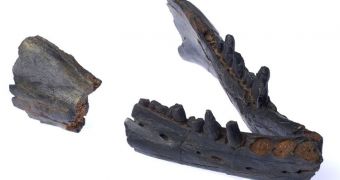During a recent scientific investigation, researchers were able to identify a special fossil, which apparently belonged to what is now known to be the oldest baleen whale ever discovered. The study covered a gap in the data we had on the evolution of the gaping maw modern blue whales display.
The blue whale is the largest animal to have ever lived on Earth, at least of all species living and extinct we know of today. It can reach a length of up to 30 meters (98 feet) and can exceed 180 metric tons (200 short tons) in weight.
One of the physical traits that immediately separates this species from any other whale is their huge elastic jaws, which the massive animals use to filter through large volumes of water in one go. The recently-discovered fossils essentially allowed biologists to determine how this type of jaw evolved.
By analyzing the remnants, which belonged to an ancient baleen whale, experts were able to determine that the flexible jaw was originally a lot more rigid. Over millions of years, the bone and its anchors developed in such a way so as to respond to the demands the whales' environments made.
“The earliest baleen whales lacked one of the hallmarks of all living (and most fossil) baleen whales: a loose lower jaw joint,” a statement from research scientist Erich Fitzgerald reads.
“Without that loose lower jaw joint, living baleen whales could simply not feed the way they do,” adds the expert, who holds an appointment with the Museum Victoria in Australia. Baleen whales are also known as filter-feeders, since they do not have the teeth killer whales and dolphins do.
While swimming, stretchy tissues anchoring the jaw bone to the whales' skulls allows them to open their mouths to a steep angle. This enables the animals to engulf a large volume of water, from which they filter all creatures and organisms (hence their name).
The ancient whale species that enabled researchers to arrive at this conclusion is called Janjucetus hunderi. Paleontologists say that it lived about 25 million years ago, after which time it went extinct.
“Janjucetus and the earliest mysticetes did not have the loose lower jaws that allows their living cousins to increase their mouth size and engulf huge volumes of seawater when filter-feeding on plankton such as krill and small fish. Janjucetus is a baleen whale, but not as we know them,” Fitzgerald explains.
The animal was only 3 meter (10 feet) in length, which made them about the size of a modern dolphin. Since that time, the descending species that eventually turned into the blue whale saw fit to increase body size drastically, in order to allow for even bigger jaws.
Details of the new scientific study appear in the August 16 issue of the journal Biology Letters, LiveScience reports.

 14 DAY TRIAL //
14 DAY TRIAL //